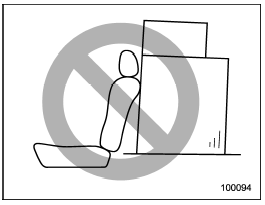Loading your vehicle

- Never allow passengers to ride on a folded rear seatback or in the cargo area. Doing so may result in serious injury.
- Never stack luggage or other cargo higher than the top of the seatback because it could tumble forward and injure passengers in the event of a sudden stop or accident. Keep luggage or cargo low, as close to the floor as possible.


- When you carry something inside the vehicle, secure it whenever you can to prevent it from being thrown around inside the vehicle during sudden stops, sharp turns or in an accident.
- Do not pile heavy loads on the roof. These loads raise the vehicle’s center of gravity and make it more prone to tip over.
- Secure lengthy items properly to prevent them from shooting forward and causing serious injury during a sudden stop.
- Never exceed the maximum load limit. If you do, some parts on your vehicle can break, or it can change the way your vehicle handles. This could result in loss of control and cause personal injury. Also, overloading can shorten the life of your vehicle.
- Do not place anything on the extended cargo area cover. Such items could tumble forward in the event of a sudden stop or a collision. This could cause serious injury.

Do not carry spray cans, containers with flammable or corrosive liquids or any other dangerous items inside the vehicle.
NOTE
For better fuel economy, do not carry
unneeded cargo.
See also:
Rear passenger’s cup holder
A dual cup holder is built in the armrest.
CAUTION
When a cup containing a beverage is in the cup holder, do not fold down or recline
any seat. Otherwise, the beverage could spill while driving ...
Ventilation
Ventilation
To force outside air through the instrument
panel outlets:
1. Set the air inlet selection button to the
OFF position.
2. Set the airflow control dial to the “”
position.
3. ...
Temporary spare tire
WARNING
● Never tow a trailer when the temporary spare tire is used. The temporary spare
tire is not designed to sustain the towing load. Use of the temporary spare tire
when towing can res ...


